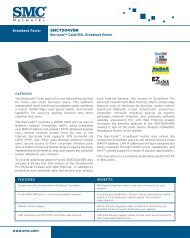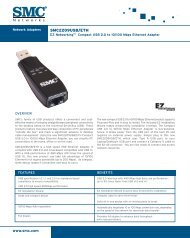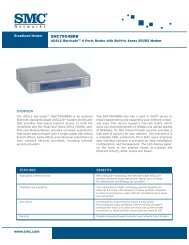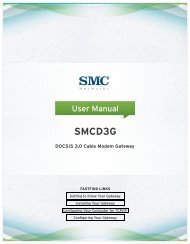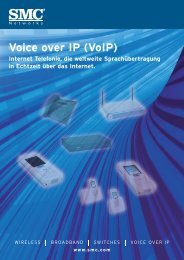PRODUCT CATALOG - SMC
PRODUCT CATALOG - SMC
PRODUCT CATALOG - SMC
You also want an ePaper? Increase the reach of your titles
YUMPU automatically turns print PDFs into web optimized ePapers that Google loves.
PLUG AND PLAY<br />
A mechanism by which I/O devices are configured automatically<br />
upon installation.<br />
PORT<br />
(1) The entrance or physical access point to a repeater,<br />
computer, multiplexer, device or network where signals<br />
may be supplied, extracted or observed.<br />
(2) To convert software to run in a<br />
different computer environment.<br />
PORT MIRRORING<br />
Method of monitoring network traffic that forwards a copy<br />
of each incoming and outgoing packet from one port of a<br />
network switch to another port where the packet can be<br />
studied.<br />
PORT TRUNKING<br />
This allows several ports to be grouped together into one<br />
logical port which allows a high speed connection. Port<br />
trunking is used when interconnecting switches.<br />
PPP (POINT-TO-POINT PROTOCOL)<br />
PPP is the Internet standard for serial communications.<br />
PPP defines how your modem connection exchanges data<br />
packets with other systems on the Internet.<br />
PPPoA (PPP over ATM)<br />
Data packets are exchanged over ATM<br />
PPPoE<br />
Acronym for Point-to-Point Protocol over Ethernet. PPPoE<br />
relies on two widely accepted standards: PPP and Ethernet.<br />
PPPoE is a specification for connecting the users on an<br />
Ethernet to the Internet through a common broadband<br />
medium, such as a single DSL line, wireless device or cable<br />
modem. All the users over the Ethernet share a common<br />
connection, so the Ethernet principles supporting multiple<br />
users in a LAN combine with the principles of PPP, which<br />
apply to serial connections.<br />
PPTP (POINT-TO-POINT TUNNELING PROTOCOL)<br />
PPTP is a protocol allows secure transmission of data in<br />
TCP/IP packets. PPTP and similar protocols are used to<br />
carry secure communications over Virtual Private Networks<br />
that use public phone lines.<br />
PROTOCOL<br />
Rules governing transmitting and receiving of data.<br />
PROXY SERVER<br />
In an enterprise that uses the Internet, a proxy<br />
server is a server that acts as an intermediary<br />
between a workstation user and the Internet so<br />
that the enterprise can ensure security, administrative<br />
control, and caching service. A proxy server<br />
is associated with or part of a gateway server<br />
that separates the enterprise network<br />
from the outside network and a firewall<br />
server that protects the enterprise<br />
network from outside intrusion.<br />
QoS<br />
This is short for Quality of<br />
service, a networking term<br />
that specifies a guaranteed<br />
throughput level.<br />
REPEATER<br />
In communications, a device that<br />
amplifies or regenerates the data signal<br />
SUPPORT & SERVICE<br />
GLOSSARY<br />
44<br />
in order to extend the distance of the transmission.<br />
Available for both analogue and digital signals, it is used<br />
extensively in long distance transmission to keep signals<br />
from losing their strength. It is also used in LANs.<br />
RIP (ROUTING INFORMATION PROTOCOL)<br />
RIP teaches routers on a wide area network which routers<br />
have access to which addresses. RIP bases its routing<br />
path on the distance (number of hops) to the destination.<br />
RIP maintains optimum routing paths by sending out routing<br />
update messages if the network topology changes.<br />
RMON (REMOTE NETWORK MONITORING)<br />
Provides standard information that a network administrator<br />
can use to monitor, analyze, and troubleshoot a group of<br />
distributed local area networks (LANs).<br />
ROAMING<br />
In wireless communications, the movement by a user<br />
among many cells or zones. The term implies that the<br />
system can locate the handset as it "roams" and provide<br />
continuing service.<br />
ROUTER<br />
In communications, a device that examines the destination<br />
address of a message and selects the most effective<br />
route. A router receives physical layer signals from a<br />
network, performs data link and network layer protocol<br />
processing, then sends the signals via appropriate data<br />
link and physical layer protocols to another network.<br />
STANDARDS FOR LANS<br />
IEEE 802.1 - Standard for local area networks which covers<br />
network management and other aspects related to LANs.<br />
IEEE 802.2 - Specifies the Logical Link Control (data link<br />
layer) for the following access methods (physical layer)<br />
IEEE 802.3 - Specifies CSMA/CD, popularized by Ethernet.<br />
IEEE 802.3u - A revision of IEEE 802.3 for 100BASE-TX<br />
Fast Ethernet.<br />
IEEE 802.11 - Defines wireless local area networks at a rate<br />
of either 1Mbps or 2Mbps.<br />
IEEE 802.11a - WLAN transmission developed in 1999 for<br />
networks with speeds up to 54Mbps and beyond.<br />
IEEE 802.11b - Addition to the IEEE 802.11 standard for<br />
WLANs that added two higher speeds, 5.5Mbps and<br />
11Mbps; also known as Wi-Fi.<br />
IEEE 802.11g - Standard for WLAN with speeds up to<br />
54Mbps using the ISM band; designed to interoperate<br />
with both IEEE 802.11a AND IEEE 802.11b devices.<br />
SDSL<br />
Symmetric digital subscriber line, a new technology that<br />
allows more data to be sent over existing copper telephone<br />
lines (POTS). SDSL supports data rates up to 3Mbps.<br />
SEGMENT<br />
A separate LAN or collision domain.<br />
SEGMENTABLE STACK<br />
Stackable Hubs capable for subdividing the LAN into<br />
separate collision domains.<br />
SERVER<br />
A computer that is on the network and shares resources<br />
with other network users. The server may be dedicated,<br />
which means that its sole purpose is to provide service<br />
for network users, or it may be used as a client.








